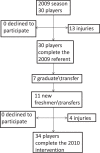Soccer-specific warm-up and lower extremity injury rates in collegiate male soccer players
- PMID: 23848519
- PMCID: PMC3867089
- DOI: 10.4085/1062-6050-48.4.08
Soccer-specific warm-up and lower extremity injury rates in collegiate male soccer players
Abstract
Context: A number of comprehensive injury-prevention programs have demonstrated injury risk-reduction effects but have had limited adoption across athletic settings. This may be due to program noncompliance, minimal exercise supervision, lack of exercise progression, and sport specificity. A soccer-specific program described as the F-MARC 11+ was developed by an expert group in association with the Federation Internationale de Football Association (FIFA) Medical Assessment and Research Centre (F-MARC) to require minimal equipment and implementation as part of regular soccer training. The F-MARC 11+ has been shown to reduce injury risk in youth female soccer players but has not been evaluated in an American male collegiate population.
Objective: To investigate the effects of a soccer-specific warm-up program (F-MARC 11+) on lower extremity injury incidence in male collegiate soccer players.
Design: Cohort study.
Setting: One American collegiate soccer team followed for 2 seasons.
Patients or other participants: Forty-one male collegiate athletes aged 18-25 years.
Intervention(s): The F-MARC 11+ program is a comprehensive warm-up program targeting muscular strength, body kinesthetic awareness, and neuromuscular control during static and dynamic movements. Training sessions and program progression were monitored by a certified athletic trainer.
Main outcome measure(s): Lower extremity injury risk and time lost to lower extremity injury.
Results: The injury rate in the referent season was 8.1 injuries per 1000 exposures with 291 days lost and 2.2 injuries per 1000 exposures and 52 days lost in the intervention season. The intervention season had reductions in the relative risk (RR) of lower extremity injury of 72% (RR = 0.28, 95% confidence interval = 0.09, 0.85) and time lost to lower extremity injury (P < .01).
Conclusions: This F-MARC 11+ program reduced overall risk and severity of lower extremity injury compared with controls in collegiate-aged male soccer athletes.
Figures
References
-
- FIFA. 270 Million people active in football. 2006 http://www.fifa.com/mm/document/fifafacts/bcoffsurv/bigcount.statspackag....
-
- Junge A, Dvorak J. Soccer injuries: a review on incidence and prevention. Sports Med. 2004;34(13):929–938. - PubMed
-
- Lohmander LS, Ostenberg A, Englund M, Roos H. High prevalence of knee osteoarthritis, pain, and functional limitations in female soccer players twelve years after anterior cruciate ligament injury. Arthritis Rheum. 2004;50(10):3145–3152. - PubMed
MeSH terms
LinkOut - more resources
Full Text Sources
Other Literature Sources
Medical


